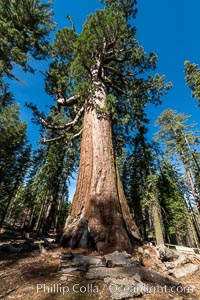
The Grizzly Giant Sequoia Tree in Yosemite. Giant sequoia trees (Sequoiadendron giganteum), roots spreading outward at the base of each massive tree, rise from the shaded forest floor. Mariposa Grove, Yosemite National Park.
Location: Mariposa Grove, Yosemite National Park, California
Image ID: 36401
Location: Mariposa Grove, Yosemite National Park, California
Image ID: 36401
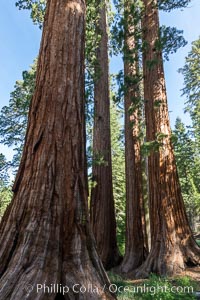
The Bachelor and Three Graces giant sequoia trees. Giant sequoia trees (Sequoiadendron giganteum), roots spreading outward at the base of each massive tree, rise from the shaded forest floor. Mariposa Grove, Yosemite National Park.
Location: Mariposa Grove, Yosemite National Park, California
Image ID: 36400
Location: Mariposa Grove, Yosemite National Park, California
Image ID: 36400
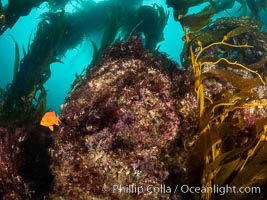
Macrocystis kelp growing up from a rocky reef, the kelp's holdfast is like a root cluster which attaches the kelp to the rocky reef on the oceans bottom. Kelp blades are visible above the holdfast, swaying in the current.
Species: Giant kelp, Macrocystis pyrifera
Location: San Clemente Island, California
Image ID: 37053
Species: Giant kelp, Macrocystis pyrifera
Location: San Clemente Island, California
Image ID: 37053
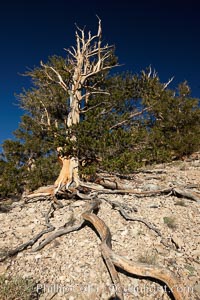
Ancient bristlecone pine tree, roots spread wide and exposed over dolomite-rich soil, rising above the arid slopes of the Schulman Grove in the White Mountains at an elevation of 9500 above sea level, along the Methuselah Walk. The oldest bristlecone pines in the world are found in the Schulman Grove, some of them over 4700 years old. Ancient Bristlecone Pine Forest.
Species: Bristlecone pine, Pinus longaeva
Location: White Mountains, Inyo National Forest, California
Image ID: 23234
Species: Bristlecone pine, Pinus longaeva
Location: White Mountains, Inyo National Forest, California
Image ID: 23234
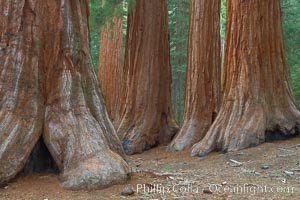
Giant sequoia trees, roots spreading outward at the base of each massive tree, rise from the shaded forest floor.
Species: Giant sequoia tree, Sequoiadendron giganteum
Location: Mariposa Grove, Yosemite National Park, California
Image ID: 23258
Species: Giant sequoia tree, Sequoiadendron giganteum
Location: Mariposa Grove, Yosemite National Park, California
Image ID: 23258
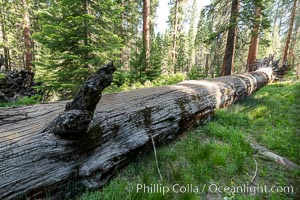
The Fallen Monarch tree. Giant sequoia trees (Sequoiadendron giganteum), roots spreading outward at the base of each massive tree, rise from the shaded forest floor. Mariposa Grove, Yosemite National Park.
Location: Mariposa Grove, Yosemite National Park, California
Image ID: 36399
Location: Mariposa Grove, Yosemite National Park, California
Image ID: 36399
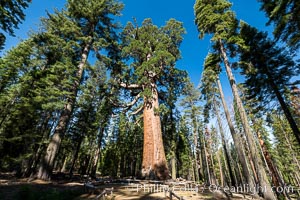
The Grizzly Giant Sequoia Tree in Yosemite. Giant sequoia trees (Sequoiadendron giganteum), roots spreading outward at the base of each massive tree, rise from the shaded forest floor. Mariposa Grove, Yosemite National Park.
Location: Mariposa Grove, Yosemite National Park, California
Image ID: 36402
Location: Mariposa Grove, Yosemite National Park, California
Image ID: 36402
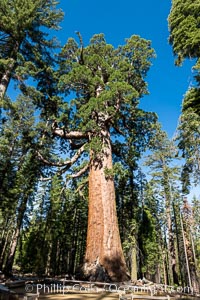
The Grizzly Giant Sequoia Tree in Yosemite. Giant sequoia trees (Sequoiadendron giganteum), roots spreading outward at the base of each massive tree, rise from the shaded forest floor. Mariposa Grove, Yosemite National Park.
Location: Mariposa Grove, Yosemite National Park, California
Image ID: 36403
Location: Mariposa Grove, Yosemite National Park, California
Image ID: 36403
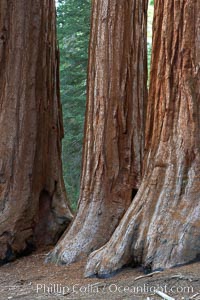
Giant sequoia trees, roots spreading outward at the base of each massive tree, rise from the shaded forest floor.
Species: Giant sequoia tree, Sequoiadendron giganteum
Location: Mariposa Grove, Yosemite National Park, California
Image ID: 23257
Species: Giant sequoia tree, Sequoiadendron giganteum
Location: Mariposa Grove, Yosemite National Park, California
Image ID: 23257
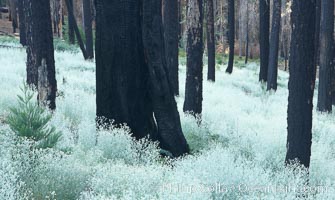
Lowlying plants grow where a forest fire has cleared the forest floor of debris, allowing seeds of small shrubs and trees to take root. The charred and burnt trees remain behind, some of them still alive in spite of their blackened appearance.
Location: Mariposa Grove, Yosemite National Park, California
Image ID: 23262
Location: Mariposa Grove, Yosemite National Park, California
Image ID: 23262
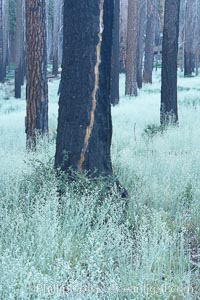
Lowlying plants grow where a forest fire has cleared the forest floor of debris, allowing seeds of small shrubs and trees to take root. The charred and burnt trees remain behind, some of them still alive in spite of their blackened appearance.
Location: Mariposa Grove, Yosemite National Park, California
Image ID: 23277
Location: Mariposa Grove, Yosemite National Park, California
Image ID: 23277
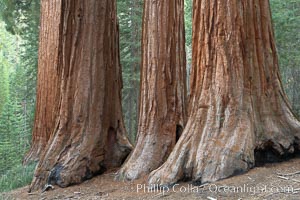
Giant sequoia trees, roots spreading outward at the base of each massive tree, rise from the shaded forest floor.
Species: Giant sequoia tree, Sequoiadendron giganteum
Location: Mariposa Grove, Yosemite National Park, California
Image ID: 23288
Species: Giant sequoia tree, Sequoiadendron giganteum
Location: Mariposa Grove, Yosemite National Park, California
Image ID: 23288
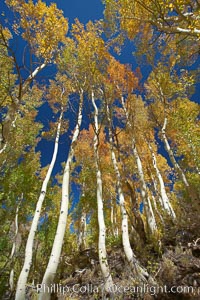
White trunks of aspen trees, viewed upward toward the yellow and orange leaves of autumn and the blue sky beyond.
Species: Aspen, Populus tremuloides
Location: Bishop Creek Canyon, Sierra Nevada Mountains, California
Image ID: 23337
Species: Aspen, Populus tremuloides
Location: Bishop Creek Canyon, Sierra Nevada Mountains, California
Image ID: 23337
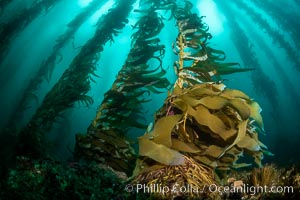
Macrocystis kelp growing up from a rocky reef, the kelp's holdfast is like a root cluster which attaches the kelp to the rocky reef on the oceans bottom. Kelp blades are visible above the holdfast, swaying in the current.
Species: Giant kelp, Macrocystis pyrifera
Location: San Clemente Island, California
Image ID: 37075
Species: Giant kelp, Macrocystis pyrifera
Location: San Clemente Island, California
Image ID: 37075
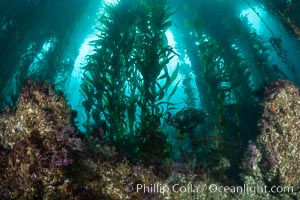
Macrocystis kelp growing up from a rocky reef, the kelp's holdfast is like a root cluster which attaches the kelp to the rocky reef on the oceans bottom. Kelp blades are visible above the holdfast, swaying in the current.
Species: Giant kelp, Macrocystis pyrifera
Location: San Clemente Island, California
Image ID: 37085
Species: Giant kelp, Macrocystis pyrifera
Location: San Clemente Island, California
Image ID: 37085
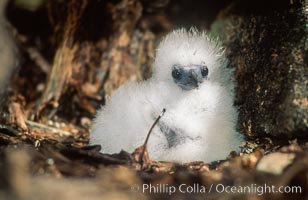
Seabird chick nested among roots of Pisonia trees, Rose Atoll National Wildlife Refuge.
Location: Rose Atoll National Wildlife Sanctuary, American Samoa
Image ID: 00888
Location: Rose Atoll National Wildlife Sanctuary, American Samoa
Image ID: 00888
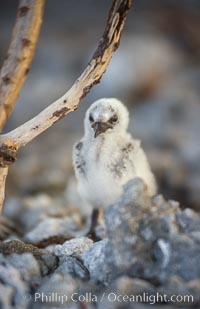
Seabird chick nested among roots of Pisonia trees, Rose Atoll National Wildlife Refuge.
Location: Rose Atoll National Wildlife Sanctuary, American Samoa
Image ID: 00889
Location: Rose Atoll National Wildlife Sanctuary, American Samoa
Image ID: 00889
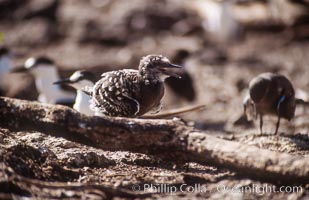
Seabird chick nested among roots of Pisonia trees, Rose Atoll National Wildlife Refuge.
Location: Rose Atoll National Wildlife Sanctuary, American Samoa
Image ID: 00891
Location: Rose Atoll National Wildlife Sanctuary, American Samoa
Image ID: 00891
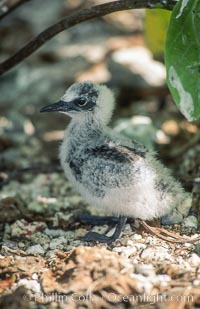
Seabird chick nested among roots of Pisonia trees, Rose Atoll National Wildlife Refuge.
Location: Rose Atoll National Wildlife Sanctuary, American Samoa
Image ID: 00893
Location: Rose Atoll National Wildlife Sanctuary, American Samoa
Image ID: 00893
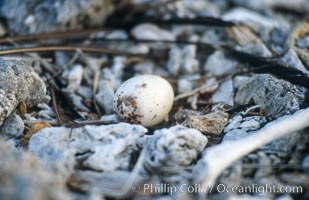
Seabird chick nested among roots of Pisonia trees, Rose Atoll National Wildlife Refuge.
Location: Rose Atoll National Wildlife Sanctuary, American Samoa
Image ID: 00894
Location: Rose Atoll National Wildlife Sanctuary, American Samoa
Image ID: 00894
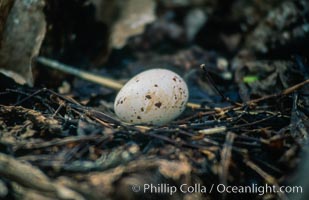
Seabird chick nested among roots of Pisonia trees, Rose Atoll National Wildlife Refuge.
Location: Rose Atoll National Wildlife Sanctuary, American Samoa
Image ID: 00895
Location: Rose Atoll National Wildlife Sanctuary, American Samoa
Image ID: 00895
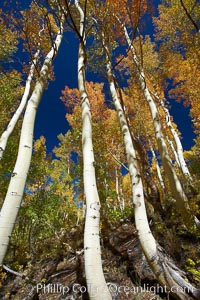
White trunks of aspen trees, viewed upward toward the yellow and orange leaves of autumn and the blue sky beyond.
Species: Aspen, Populus tremuloides
Location: Bishop Creek Canyon, Sierra Nevada Mountains, California
Image ID: 23385
Species: Aspen, Populus tremuloides
Location: Bishop Creek Canyon, Sierra Nevada Mountains, California
Image ID: 23385
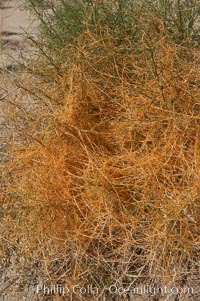
California dodder, a common stem parasite in California that typically parasitizes host shrubs. Dodders resemble tangled masses of orange spaghetti covering shrubs. Dodder is without chlorophyll and are nonphotosynthetic and is therefor an obligate parasite dependent on its host for water and nutrients through a root system that penetrates the stem tissue of the host.
Species: California dodder, Cuscuta californica
Image ID: 11333
Species: California dodder, Cuscuta californica
Image ID: 11333
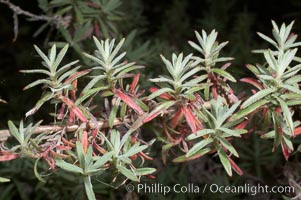
California fuschia, Batiquitos Lagoon, Carlsbad, California. A member of the primrose family. Local tribes occasionally ate seeds of this species, while leaves and roots were sometimes boiled and eaten. Settlers gathered seeds and used them as a natural remedy for a variety of illnesses, effectively, since this species contains gamma-linoleic acid.
Species: California fuschia, Epilobium cana
Location: Batiquitos Lagoon, Carlsbad, California
Image ID: 11334
Species: California fuschia, Epilobium cana
Location: Batiquitos Lagoon, Carlsbad, California
Image ID: 11334
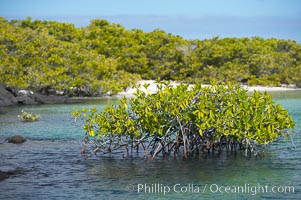
Mangrove shoreline. Mangroves have vertical branches, pheumatophores, that serve to filter out salt and provide fresh water to the leaves of the plant. Many juvenile fishes and young marine animals reside in the root systems of the mangroves. Punta Albemarle.
Location: Isabella Island, Galapagos Islands, Ecuador
Image ID: 16607
Location: Isabella Island, Galapagos Islands, Ecuador
Image ID: 16607
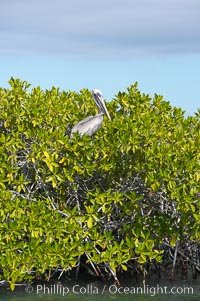
Mangrove shoreline. Mangroves have vertical branches, pheumatophores, that serve to filter out salt and provide fresh water to the leaves of the plant. Many juvenile fishes and young marine animals reside in the root systems of the mangroves. Punta Albemarle.
Location: Isabella Island, Galapagos Islands, Ecuador
Image ID: 16608
Location: Isabella Island, Galapagos Islands, Ecuador
Image ID: 16608
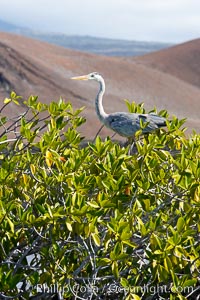
Mangrove shoreline. Mangroves have vertical branches, pheumatophores, that serve to filter out salt and provide fresh water to the leaves of the plant. Many juvenile fishes and young marine animals reside in the root systems of the mangroves. Punta Albemarle.
Location: Isabella Island, Galapagos Islands, Ecuador
Image ID: 16609
Location: Isabella Island, Galapagos Islands, Ecuador
Image ID: 16609
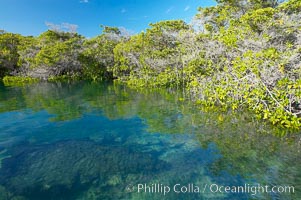
Mangrove shoreline. Mangroves have vertical branches, pheumatophores, that serve to filter out salt and provide fresh water to the leaves of the plant. Many juvenile fishes and young marine animals reside in the root systems of the mangroves. Punta Albemarle.
Location: Isabella Island, Galapagos Islands, Ecuador
Image ID: 16610
Location: Isabella Island, Galapagos Islands, Ecuador
Image ID: 16610
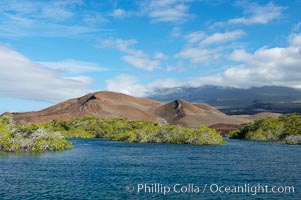
Mangrove shoreline. Mangroves have vertical branches, pheumatophores, that serve to filter out salt and provide fresh water to the leaves of the plant. Many juvenile fishes and young marine animals reside in the root systems of the mangroves. Punta Albemarle.
Location: Isabella Island, Galapagos Islands, Ecuador
Image ID: 16611
Location: Isabella Island, Galapagos Islands, Ecuador
Image ID: 16611
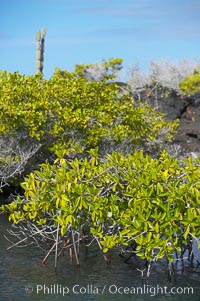
Mangrove shoreline. Mangroves have vertical branches, pheumatophores, that serve to filter out salt and provide fresh water to the leaves of the plant. Many juvenile fishes and young marine animals reside in the root systems of the mangroves. Punta Albemarle.
Location: Isabella Island, Galapagos Islands, Ecuador
Image ID: 16612
Location: Isabella Island, Galapagos Islands, Ecuador
Image ID: 16612